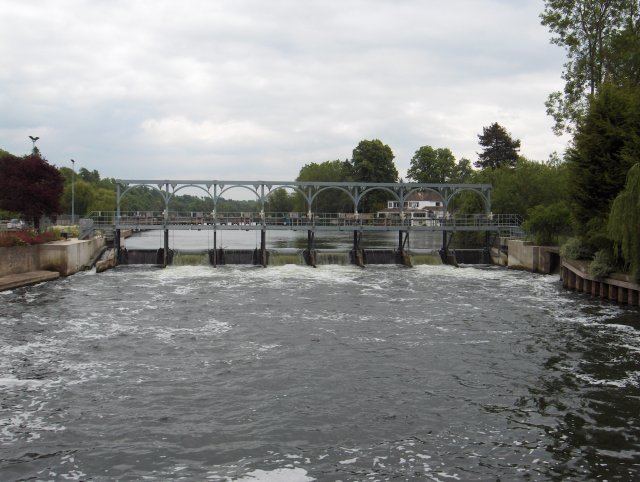 | ||
A sluice (from the Dutch "sluis") is a water channel controlled at its head by a gate. A mill race, leet, flume, penstock or lade is a sluice channelling water toward a water mill. The terms sluice, sluice gate, knife gate, and slide gate are used interchangeably in the water and wastewater control industry.
Contents
- Operation
- Types of sluice gates
- Logging sluices
- Placer mining applications
- Types of material used for sluice gates
- Regional names for sluice gates
- References
A sluice gate is traditionally a wood or metal barrier sliding in grooves that are set in the sides of the waterway. Sluice gates commonly control water levels and flow rates in rivers and canals. They are also used in wastewater treatment plants and to recover minerals in mining operations, and in watermills.
Operation
"Sluice gate" refers to a movable gate allowing water to flow under it. When a sluice is lowered, water may spill over the top, in which case the gate operates as a weir. Usually, a mechanism drives the sluice up or down. This may be a simple, hand-operated, chain pulled/lowered, worm drive or rack-and-pinion drive, or it may be electrically or hydraulically powered.
Types of sluice gates
The gates of a Guillotine lock work in a way similar to a sluice gate, but most canal lock gates are hinged to swing like doors.
Logging sluices
In the mountains of the United States, sluices transported logs from steep hillsides to downslope sawmill ponds or yarding areas. Nineteenth-century logging was traditionally a winter activity for men who spent summers working on farms. Where there were freezing nights, water might be applied to logging sluices every night so a fresh coating of slippery ice would reduce friction of logs placed in the sluice the following morning.
Placer mining applications
Sluice boxes are often used in the recovery of black sands, gold, and other minerals from placer deposits during placer mining operations. They may be small-scale, as used in prospecting, or much larger, as in commercial operations, where the material is first screened using a trommel or screening plant. Typical sluices have transverse riffles over a carpet, which trap the heavy minerals, gemstones, and other valuable minerals. The result is a concentrate.
Types of material used for sluice gates
Regional names for sluice gates
In the Somerset Levels, sluice gates are known as clyse or clyce.
Most of the inhabitants of Guyana refer to sluices as kokers.
Sinhala people in Sri Lanka who had a harvested rain water based ancient civilization refer to sluices as Horovuwa.
